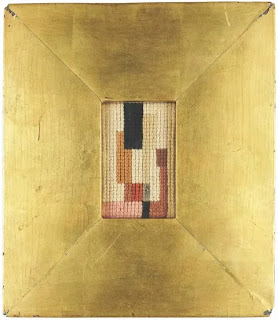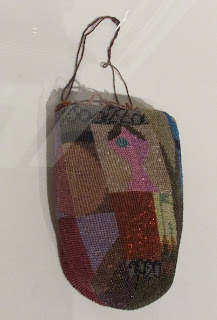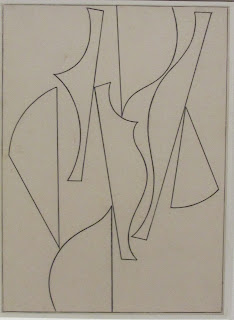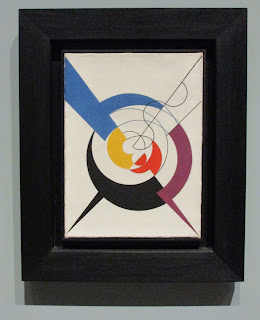Sophie Taeuber-Arp - Equilibrium,
"Only when we go into ourselves and attempt to be entirely true to ourselves will we succeed in making things of value, living things, and in this way help to develop a new style that is fitting for us." - Sophie Taeuber-Arp, 1922.
I wasn't quite sure what to expect from this exhibition. I had experienced some of polymath Sophie Taeuber-Arp's art through her designs for the modernist entertainment space L'Aubette in Strasbourg (here), and was aware of her associations with the Dada movement. I was much more familiar with the work of her husband Hans (Jean) Arp, than Taeuber-Arp's own. It was love at first sight on seeing her artwork however, as Taeuber-Arp's multi-disciplinary art encompassed all of the current interests in the development of my own work. Geometric grid structures. Check. Textiles. Check. Abstraction. Check. Collage. Double check! This exhibition ticked all of my boxes. I admired Taeuber-Arp's singular aesthetic rooted in geometry in her approach to her art and design. I felt it was all the stronger for the fact that she was trained at schools that emphasised the Bauhaus principles of the interrelationship between fine art, craft and design, and that she didn't seem to adhere to any art/design distinctions or hierarchy. Throughout her career she moved seemlessly between disciplines as an architect, interior designer, painter, performer, designer of textiles, woodworker, teacher and artist. Taeuber-Arp executed work in all disciplines to an equally high standard. Other modernists creating art at the period of the First World War arrived at abstraction through the breaking down of figurative elements in their art. Taeuber-Arp's abstraction though was derived from the very beginning with the drawing of geometric grid structures in her early textile investigations. The grid and bold, geometric shapes would underpin and inform all aspects of her oeuvre throughout the length of her career. This uplifting, revelatory, delightful exhibition displays all facets of that oeuvre, and is all the more interesting for showing just how talented and versatile Taeuber-Arp was as an artist/designer with such a distinctive visual style. Included are the delightful wood-turned marionettes for the production of Carlo Gozzi's 18th-century play King Stag, beaded jewellery, embroidered/needlepoint textiles and tapestry rugs, stained glass and architectural/furniture designs and of course those wonderful abstract paintings. Art historical revisionism has tried to restore the reputations of certain artists who were previously overlooked or who had fallen into obscurity. As a consequence of trying to redress the balance the contributions of some artists have perhaps been unjustly over-hyped. Sophie Taeuber-Arp's multi-disciplinary work in my opinion fully deserves all of the hyperbole and plaudits. This exhibition is a gem and will hopefully expose her work to a larger audience.
Stained glass window for the apartment of André Horn, Strasbourg, 1928
Off-Centre Composition with White Lines (design for the apartment of André Horn, Strasbourg, 1928)
Stained glass design for the Aubette, 1927
Tapestry, c.1925
Drawing (used as an illustration for Jean (Hans) Arp's 1939 book of poetry Shells and Umbrellas), 1937
Sophie Taeuber-Arp
until 17th October
Tate Modern
Bankside
London
SE1







































































No comments:
Post a Comment